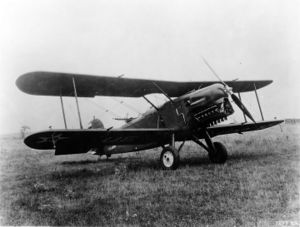Maroto FA-1
| Maroto FA-1 | |
|---|---|

| |
| A Maroto FA-1 in 1942. | |
Role
|
Attack aircraft |
National origin
|
|
Manufacturer
|
Maroto Aircraft Company |
Designer
|
Mauricio Maroto Galván |
First flight
|
November 1927 |
Introduction
|
February 1928 |
Retired
|
1972 |
Status
|
Retired; various aircraft on display |
Primary users
|
Creeperian Air Force Pavulturilori Air Force Castillianan Air Force Atlántidan Air Force |
Produced
|
1927–1944 |
Number built
|
540 |
Developed from
|
Maroto E-1 |
The Maroto FA-1, nicknamed the Guerrillero (literally "war fighter"), is a Creeperian single-engine biplane attack aircraft built by the Maroto Aircraft Company. The aircraft was the first to be mass produced by Maroto Aircraft; from 1927 to 1944, 540 Maroto FA-1s were built. The aircraft saw extensive usage throughout the Creeperian Civil War and saw service with various countries. Although the aircraft was retired by the Creeperian Air Force in 1952, it continued service with other air forces until 1972. Various Maroto FA-1s are on display in museums.
Development and design
In 1926, the Creeperian Air Force (FAAC) ordered an attack aircraft from the Maroto Aircraft Company to compliment the Maroto E-1 reconnaissance aircraft which was already in service. Between 1926 and 1927, Mauricio Maroto Galván personally designed the aircraft and the first prototype was built in late-1927. The aircraft was named the Maroto FA-1, with "FA" standing for Fuerza Aérea (Creeperian Spanish for "Air Force").
The FA-1 had its first flight in November 1927 at the San Salvador International Airport, the airport where the Maroto Aircraft Company had its manufacturing facility. Maroto Galván was in attendance of the aircraft's first flight, as were Antonio Sáenz Heredia, the then prime minister of Creeperopolis, and Raúl Castañeda Ocampo, the then commander of the air force. Both Sáenz Heredia and Castañeda Ocampo were reportedly impressed with the FA-1's performance and placed an order for 50 aircraft, the largest order of any aircraft produced by Maroto up to that point.
The aircraft was developed from the E-1; the FA-1 was a two-seated single-engine biplane. Compared to the E-1, the FA-1 had a more powerful engine—a 453 horsepower Ribelles FA-1 (replacing the E-1's 435 horsepower Reyes C-1 engine—and eight machine guns, six forward-facing Figueroa-30s (two in the fuselage and one on each wing) controlled by the pilot and two flexible Figueroa-31s controlled by the observer/gunner, compared to the E'1 single Figueroa-30 machine gun. The FA-1 could also carry 100 lb (45 kg) of bombs mounted on the lower wing racks.
Service history
The Maroto FA-1 entered production in December 1927 and entered service with the Creeperian Air Force once the first aircraft were delivered in February 1928. The aircraft entered service during the early months of the Crisis of 1928, a period of increased paramilitary and political violence in Creeperopolis, and some Creeperian politicians called upon the air force to intervene in the crisis using the newly acquired FA-1. Air force leadership rejected the pleas made by politicians, but Sáenz Heredia and Joel Lacasa Campos did consider utilizing the FA-1 against paramilitaries which opposed their governments. When Tobías Gaos Nores assumed office in March 1928, he passed a law through the parliament to ban the Creeperian Air Force from utilizing the FA-1 specifically against paramilitary forces.
Operators
Specifications
General characteristics
- Crew: Two (pilot & observer/gunner)
- Length: 29 ft 7 in (9.02 m)
- Wingspan: 39 ft 8 in (12.09 m)
- Height: 11 ft (3.4 m)
- Max takeoff weight: 4,985 lb (2,261 kg)
- Powerplant: 1 × Ribelles FA-1 inverted air-cooled V-12 piston engine, 453 hp (338 kW)
Performance
- Maximum speed: 130 mph (210 km/h, 110 kn)
- Cruise speed: 100 mph (160 km/h, 87 kn)
- Range: 400 mi (640 km, 350 nmi)
- Service ceiling: 15,000 ft (4,600 m)
Armament
- Guns:
- 6 × forward firing .30-cal. (7.62 mm) Figueroa-30 machine guns, two in the fuselage + one in each wing
- 2 × flexible .30-cal. Figueroa-31 machine guns
- Bombs: Provision for 100 lb (45 kg) of bombs mounted on lower wing racks

